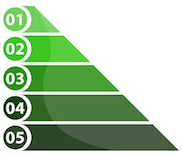5 Steps We Can Take to Accommodate the Core
A MiddleWeb Blog
 Is it realistic to expect that students with disabilities (outside of the small percentage of students who will qualify for alternate assessment) be able to master the new and more challenging Common Core State Standards in ELA and math?
Is it realistic to expect that students with disabilities (outside of the small percentage of students who will qualify for alternate assessment) be able to master the new and more challenging Common Core State Standards in ELA and math?
Recently I facilitated a PD session with 25 special education teachers and put this question on the table for my colleagues to ponder. If you’re a special ed teacher or a content area teacher who works in a coteaching situation, I hope you’re sensing the spark of power this question holds.
I’m going to give you a moment to pause and think about your response.
Here’s what I see in my own work:
► On the one hand, advocates for students with learning disabilities are basking in the glory of a new standards approach—thrilled that these students are held to the same high expectations as their typically developing peers.
► On the other hand, if a child’s specific ability level makes it difficult for them to meet certain standards, then frustration sets in for students, teachers, and parents.
My own response: We have to join both hands together and acknowledge our differing points of view. Then we must roll up our sleeves and do what we can to guide all students to reach their full potential.
If we strike the phrase with a learning disability and instead use the phrase who learn differently, we affirm that these students are capable, not “incapable.” They just need the right balance of support and encouragement to be their personal best.
Five Connecting Steps
Following our PD session (which I titled “Accommodating and Modifying the Common Core with Integrity”), I began to think about possible steps educators should take when connecting students who learn differently to the Common Core curriculum. I came up with five.
Step 1: Set High (and Realistic, based on individuals) Expectations and Organize the Big Picture
✓ Expect students with disabilities to achieve grade-level academic content standards to the best of their abilities.
✓ Be familiar with the general education Common Core curriculum and standards.
✓ Create an outline of the scope and sequence, the big ideas, and the standards that align with each unit of study or lesson modules.
✓ Create a checklist of all IEP goals per student and class in a manner that makes sense for you to keep track of the goals.
✓ Deconstruct the standards and align key Common Core skills and strategies with the IEP goals that apply.
Step 2: Deepen your Understanding of Applying Options for Accommodating Instruction and Assessment
✓ Create a list of testing accommodations as per each student’s IEP
✓ Be sure instructional accommodations are consistent with testing accommodations—they should lead the student to be as independent as possible.
✓ Plan for scaffolding that will guide students to be independent through implementing a gradual release of responsibility.
✓ Identify ways you can implement UDL into the instructional process.
✓ Be mindful of the difference between accommodation and modification—and be careful to stay focused on the core skill and expectations.
✓ Remember, accommodations never reduce learning expectations—they level the playing field.
✓ Accommodations create access to the same content and standards for all learners.
✓ UDL and Differentiating Instruction is not an accommodation—it is effective instruction that is good for all learners.
Step 3: Select and Plan Appropriate Instructional Accommodations
✓ Always stay consistent with the student’s IEP.
✓ Ask yourself, what are the student’s learning strengths and areas of need?
✓ How do the student’s learning needs affect his ability to achieve in the curriculum? What are potential barriers? And how can I knock them down?
✓ What specialized instruction (e.g., learning strategies, organizational skills, reading skills) does the student need to achieve grade-level Content Standards?
✓ What accommodations will increase the student’s access to instruction and assessment by addressing her learning needs and reducing the effect of the student’s disability? These may be new accommodations or accommodations the student is currently using.
✓ Plan for explicit instruction in how to use the accommodation during instruction and testing situations.
✓ Plan how and when the student will learn to use each new accommodation. Be certain there is sufficient time to learn to use instructional and assessment accommodations before an assessment takes place.
✓ Accommodations use should be consistent to allow students to be as independent as possible—and to allow the student to achieve his personal best on assessments.
✓ Finally, plan for the ongoing evaluation and improvement of the student’s use of accommodations.
Step 4: Administering Accommodations During Instruction and Assessment
✓ The student must be provided with the selected accommodations during instructional periods as necessary. The goal must be to create independent, strategic learners; accommodations must be implemented consistently to guide toward independence. Apply appropriate scaffolds.
✓ Accommodations may never be used only on assessments.
✓ Administer testing accommodations as per student’s IEP.
Step 5: Evaluating and Improving Accommodations Use in Instruction and Assessment
✓ Accommodations must be selected on the basis of the individual student’s needs and must be used consistently for instruction and assessment — accommodations cannot be used for assessment only.
✓ Make sure you have a monitoring plan in place to determine the effectiveness of the accommodations. Are they providing students with scaffolding that will lead the student to be independent? Is this accommodation guiding the student to gain knowledge, skills, and strategies that are consistent with the Common Core concepts, skills, and strategies?
✓ Make sure that all accommodations provide the student with access to the same standards and expectations as their non-disabled peers.
✓ What is the student’s perception of how well the accommodation works? What is the student’s comfort level in applying? Are there any challenges in implementing the accommodations?
✓ What is the perspective of the parent in the effectiveness of the accommodations?

So tell us…how are you accommodating the Common Core with integrity? What’s happening in your classrooms?








































As an intervention specialist, I appreciated this view of common core and it’s connection to students with disabilities. I’m struggling to write standards-based IEP goals when students are more than one grade level below and I’ve found that the scaffolded standards seem to help make stronger goals. Does that seem to be the case for anyone else?
I enjoyed reading your post on this topic. I am a high school math teacher and it is our second year now implementing Common Core Algebra. It is a difficult transition for students in the regular education population let alone students with special needs, but I have seen progress as the junior highs are also adopting the standards. We are fortunate to have a literacy specialist who visits our classes weekly for extra supports. I like how you kept stressing that accommodations should lead to independent skills and that accommodations should not be used only on assessments. I think that scaffolding is a great way to encourage students to take educational risks within the structure of the classroom.